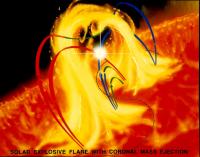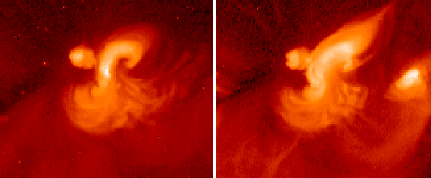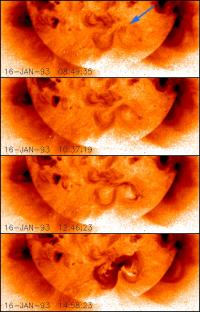
Space Science News home
Finding the 'smoking gun' before it fires
Physicists discover a new tool for predicting solar eruptions
|
"These are the solar magnetic field lines snaking around each other, forming the letter 'S'," he explained. "Usually they go past each other. But if they connect at the wrists, it's like a coronal short circuit. The mid-section pops up and drives out a coronal mass ejection, a CME. Nobody understand exactly why this happens. But you don't explode very often unless you're twisted." And until recently, no one could predict when it would happen. But a new study, published today in Geophysical Research Letters, is putting scientists on the trail of predicting such eruptions. It's something that scientists have suspected for decades, and it will help give advance notice for the Solar Vector Magnetograph (SVMG) at NASA's Marshall Space Flight Center. |
| "With the vector magnetograph, you can get in there and measure the shear in the magnetic fields," said Moore, one of the scientists who uses the SVMG. "This new finding tells us what to do with our data; where to follow up."
The "S marks the spot" finding was made by Drs. Richard Canfield and David McKenzie at Montana State University-Bozeman, and Dr. Hugh Hudson of the Solar Physics Research Corporation, Tucson, AZ. Solar activity has intrigued scientists since 1611 when Galileo turned his telescope to the sun and discovered sunspots (and eventually blinded himself, so never try this without the correct filters). Unseen to the eye, or even most telescopes, are intense magnetic fields that confine and conduct plasmas - electrified gases - over the visible surface of the sun. The effects of these magnetic fields are readily seen in the form of sinuous prominences and filaments that rise and fall above the surface.The Solar Vector Magnetograph uses a special optical package to extract the polarization from spectral lines of sunlight. From this, scientists can measure the intensity and direction of a magnetic field in a hot gas. |
Click here for a 000KB MPEG showing an S-shaped region that exploded on Oct. 25, 1994, and launched a CME toward the Earth. This one violated the hemispheric rule in that it was 2-shaped, rather than S-shaped, in the southern hemisphere. Suddenly, everything snaps back, and 10 billion tons of ionized gas are hurled into space at up to a 3 million km/h. If the gas bundle - still constrained by its own magnetic field - goes off at the right spot on the sun, it intercepts the Earth in about four days. In turn, that sets off geomagnetic storms that can damage satellites in space and shut down electrical power grids on the ground. |





 Headlines
Headlines